Heritage railway
This article needs additional citations for verification. (June 2021) |

A heritage railway or heritage railroad (U.S. usage) is a railway operated as living history to re-create or preserve railway scenes of the past. Heritage railways are often old railway lines preserved in a state depicting a period (or periods) in the history of rail transport.
Definition
The British Office of Rail and Road defines heritage railways as follows:[1]
...'lines of local interest', museum railways or tourist railways that have retained or assumed the character and appearance and operating practices of railways of former times. Several lines that operate in isolation provide genuine transport facilities, providing community links. Most lines constitute tourist or educational attractions in their own right. Much of the rolling stock and other equipment used on these systems is original and is of historic value in its own right. Many systems aim to replicate both the look and operating practices of historic former railways companies.
Infrastructure
Heritage railway lines have historic rail infrastructure which has been substituted (or made obsolete) in modern rail systems. Historical installations, such as hand-operated
Operation
Due to a lack of modern technology or the desire for historical accuracy, railway operations can be handled with traditional practices such as the use of
Cost
While some heritage railways are profitable tourist attractions, many are not-for-profit entities; some of the latter depend on enthusiastic volunteers for upkeep and operations to supplement revenue from traffic and visitors. Still other heritage railways offer a viable public-transit option, and can maintain operations with revenue from regular riders or government subsidies.
Development
Children's railways
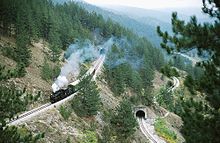

Children's railways are extracurricular educational institutions where children and teenagers learn about railway work; they are often functional, passenger-carrying narrow-gauge rail lines. The railways developed in the USSR during the Soviet era. Many were called "Pioneer railways", after the youth organisation of that name. The first children's railway opened in Moscow[2] in 1932 and, at the breakup of the USSR, 52 children's railways existed in the country.[3] Although the fall of communist governments has led to the closure of some, preserved children's railways are still functioning in post-Soviet states and Eastern European countries.
Many children's railways were built on parkland in urban areas. Unlike many industrial areas typically served by a narrow-gauge railway, parks were free of redevelopment. Child volunteers and socialist fiscal policy enabled the existence of many of these railways. Children's railways which still carry traffic have often retained their original infrastructure and rolling stock, including vintage steam locomotives;[4][5] some have acquired heritage vehicles from other railways.
Examples of children's railways with steam locomotives include the
Mountain railways
Creating passages for trains up steep hills and through
Pit railways
Underground railways
The
Heritage tramways
Heritage tram lines that offer scheduled service on a certain route and showcase historic aspects of streetcar systems are usually operated by heritage vehicles. Heritage tramlines that operate on a rail network that mainly serves the interest of modern urban mobility have difficulty in exhibiting historic tramway infrastructure, apart from the car itself. This kind of tramline is often operated mainly to attract tourists instead of providing urban access. Some technical aspects of historic tram infrastructure can prevent the use of a heritage line as an integral part of the public transport system. For example, heritage tramlines often lack handicapped access which is required by law in many countries. Heritage tramlines can be either newly installed lines (created in modern times, 1970s or later) or be surviving older tramlines that have retained use of historic trams for all or most of their scheduled service.
Rail tracks designated solely or mainly to heritage streetcar traffic offer best opportunities for preservation of historic streetcar scenes. Some heritage tramways use all-new construction while others make use of an existing, usually disused,
By country

The first heritage railway to be rescued and run entirely by volunteers was the
Argentina

In southern Argentina, the
.In
In the Misiones Province, more precisely in the Iguazú National Park, is the Ecological Train of the Forest. With a speed below 20 km per hour to avoid interfering with wildlife and the formations are propelled to liquefied petroleum gas (LPG), a non-polluting fuel.[11]
The Villa Elisa Historic Train (operated by Ferroclub Central Entrerriano) runs steam trains between the cities of Villa Elisa and Caseros in Entre Ríos Province, covering 36 km (22 mi)[12] in 120 minutes.[13]
Australia
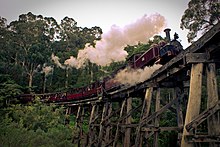
The world's second preserved railway, and the first outside the United Kingdom, was Australia's Puffing Billy Railway. This railway operates on 15 miles (24 km) of track, with much of its original rolling stock built as early as 1898. Just about over half of Australia's heritage lines are operated by narrow gauge tank engines, much like the narrow gauge lines of the United Kingdom.
Austria
The Höllental Railway is a 4.9-kilometre-long (3.0 mi), 760 mm (2 ft 5+15⁄16 in) narrow-gauge (Bosnian gauge) railway, operating in Lower Austria. It runs on summer weekends, connecting Reichenau an der Rax to the nearby Höllental.
Belgium
Flanders, Belgium's northern Dutch-speaking region, has the Dendermonde–Puurs Steam Railway; whereas Wallonia, with its strong history of 19th century heavy industries, has the Chemin de fer à vapeur des Trois Vallées and PFT operates the Chemin de Fer du Bocq.
Canada
Railways
Tramways
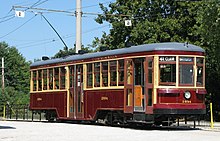
Heritage streetcar lines:
- Downtown Historic Railway, in Vancouver, B.C. Replaced temporarily by the Olympic Line during the 2010 Vancouver Olympics, abandoned in 2012.
- Nelson Electric Tramway, in Nelson, B.C.: two streetcars – Car 400 (formerly BCER, owned by the Royal BC Museum, operational since 1999)[14] and Car 23 (operational since 1992)[15] operate on a 1.2 km route from City wharf to Lakeside Park.
- Edmonton, Alberta.
- Whitehorse, Yukon. Closed in 2019.
Museums with operational heritage streetcar lines:
- Rockwood, Ontario
- Delson/Saint-Constant, Quebec
- Calgary, Alberta
- Edmonton, Alberta, operated by the Edmonton Radial Railway society along with the High Level Bridge Streetcar.
Finland
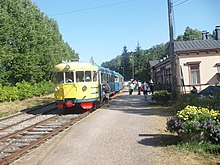
On the Finnish state-owned
The Jokioinen Museum Railway is a stretch of preserved narrow-gauge railway between Humppila and Jokioinen. Nykarleby Järnväg is a stretch of rebuilt narrow-gauge railway on the bank of the old Kovjoki–Nykarleby line.[18]
Germany

The Buckower Kleinbahn is a 4.9-kilometre (3.0 mi) spur line of the Prussian Eastern Railway, located in the Märkische Schweiz Nature Park in Brandenburg. It was originally constructed in 1897 as a narrow-gauge railway, with a gauge of 750 mm (2 ft 5+1⁄2 in), connecting Buckow to the Müncheberg (Mark) station. This line was electrified and changed to standard gauge in 1930. It has operated as a heritage railway since 2002.
India

Of the mountain railways of India, the Darjeeling Himalayan, Nilgiri Mountain and Kalka–Shimla Railways have been collectively designated as a UNESCO World Heritage Site.[19][20][21] To meet World Heritage criteria, the sites must retain some of their traditional infrastructure and culture.
Italy
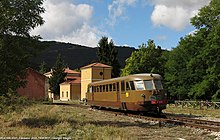
In Italy the heritage railway institute is recognized and protected by law no. 128 of 9 August 2017, which has as its objective the protection and valorisation of disused, suspended or abolished railway lines, of particular cultural, landscape and tourist value, including both railway routes and stations and the related works of art and appurtenances, on which, upon proposal of the regions to which they belong, tourism-type traffic management is applied (art. 2, paragraph 1).[22] At the same time, the law identified a first list of 18 tourist railways, considered to be of particular value (art. 2, paragraph 2).[22]
The list is periodically updated by decree of the Ministry of Infrastructure and Transport, in agreement with the Ministry of Economy and Finance and the Ministry of Culture, also taking into account the reports in the State-Regions Conference, a list which in 2022 reached 26 railway lines.[23] According to article 1, law 128/2017 has as its purpose: "the protection and valorisation of railway sections of particular cultural, landscape and tourist value, which include railway routes, stations and related works of art and appurtenances, and of the historic and tourist rolling stock authorized to travel along them, as well as the regulation of the use of ferrocycles".[22]


Below is the list of railway lines recognized as tourist railways by Italian legislation.
- Sulmona-Castel di Sangro section of the Sulmona–Isernia railway[24]
- Cosenza-Camigliatello–San Giovanni in Fiore railway[25]
- Avellino–Rocchetta Sant'Antonio railway[24]
- Gemona del Friuli–Sacile railway[24]
- Palazzolo–Paratico railway[24]
- Castel di Sangro-Carpinone section of the Sulmona-Isernia railway[26]
- Ceva–Ormea railway[24]
- Mandas–Arbatax railway[27]
- Isili–Sorgono railway[27]
- Sassari–Tempio-Palau railway[27]
- Macomer–Bosa railway[27]
- Alcantara–Randazzo railway[24]
- Castelvetrano-Porto Palo section of the Castelvetrano–Porto Empedocle railway[28]
- Agrigento Bassa-Porto Empedocle section of the Castelvetrano-Porto Empedocle railway[28]
- Noto–Pachino railway[24]
- Asciano–Monte Antico railway[24]
- Civitavecchia–Orte railway[24]
- Fano–Urbino railway[24]
|
b) pursuant to the Ministerial Decree of 30 March 2022:[23]
|

The
In July 2023,
- Luxury trains, which includes the circulation of the "Venice Simplon Orient Express, already operating on European routes;[30]
- Express and historic trains, with the express trains of the 1980s and 1990s which being redeveloped and modernized in the railway workshops of Rimini, while the historic trains are used for journeys that include stops with guided tours and tastings;[30]
- Regional trains, also with trips that include experiential tourist stops, which pass through places rich in history, with villages and areas of landscape, naturalistic, food and wine and agri-food interest.[30]
New Zealand
Rail transport played a major role in the history of New Zealand and several
Slovakia
The Čierny Hron Railway is a narrow-gauge railway in central Slovakia, established in the first decade of the 20th century and operating primarily as a freight railway for the local logging industry. From the late 1920s to the early 1960s, it also offered passenger transport between the villages of Hronec and Čierny Balog. The railway became Czechoslovakia's most extensive forest railway network. After its closure in 1982, it received heritage status and was restored during the following decade. Since 1992, it has been one of Slovakia's official heritage railways and is a key regional tourist attraction. The Historical Logging Switchback Railway in Vychylovka is a heritage railway in north-central Slovakia, originally built to serve the logging industry in the Orava and Kysuce regions. Despite a closure and dissasembly of most of its original network during the early 1970s, its surviving lines and branches have been (or are being) restored. The railway is owned and operated by the Museum of Kysuce, with a 3.8-kilometre (2.4 mi) line open to tourists for sightseeing.
Switzerland

Switzerland has a
United Kingdom
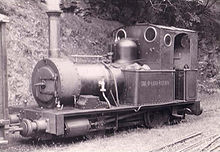
In Britain, heritage railways are often railway lines which were run as commercial railways but were no longer needed (or closed down) and were taken over or re-opened by volunteers or non-profit organisations. The large number of heritage railways in the UK is due in part to the closure of many minor lines during the 1960s' Beeching cuts, and they were relatively easy to revive. There are between 100 and 150 heritage railways in the United Kingdom.
A typical British heritage railway will use steam locomotives and original rolling stock to create a period atmosphere, although some are concentrating on diesel and electric traction to re-create the post-steam era. Many run seasonally on partial routes, unconnected to a larger network (or railway), and charge high fares in comparison with transit services; as a result, they focus on the tourist and leisure markets. During the 1990s and 2000s, however, some heritage railways aimed to provide local transportation and extend their running seasons to carry commercial passenger traffic.

The first standard-gauge line to be preserved (not a victim of Beeching) was the Middleton Railway; the second, and the first to carry passengers, was the Bluebell Railway.
Not-for-profit heritage railways differ in their quantity of service and some lines see traffic only on summer weekends. The more successful, such as the Severn Valley Railway and the North Yorkshire Moors Railway, may have up to five or six steam locomotives and operate a four-train service daily; smaller railways may run daily throughout the summer with only one steam locomotive. The Great Central Railway, the only preserved British main line with a double track, can operate over 50 trains on a busy timetable day.
After the privatisation of main-line railways, the line between not-for-profit heritage railways and for-profit branch lines may be blurred. The Romney, Hythe and Dymchurch Railway is an example of a commercial line run as a heritage operation and to provide local transportation, and the Severn Valley Railway has operated a few goods trains commercially. A number of heritage railway lines are regularly used by commercial freight operators.
Since the Bluebell Railway reopened to traffic in 1960, the definition of private
United States
Railroads


Heritage railways are known in the United States as tourist, historic, or scenic railroads. Most are remnants of original railroads, and some are reconstructed after having been scrapped. Some heritage railways preserve entire railroads in their original state using original structures, track, and motive power.

Examples of heritage railroads in the US by preservation type:
- Original
- East Broad Top Railroad and Coal Company (Pennsylvania)
- Nevada Northern Railway (Nevada)
- California Western Railroad (California)
- Stewartstown Railroad (Pennsylvania)
- Arcade and Attica Railroad (New York)
- Remnant
- Durango and Silverton Railroad (Colorado)
- Cumbres and Toltec Scenic Railroad (Colorado and New Mexico)
- Hocking Valley Scenic Railway (Ohio)
- Tennessee Valley Railroad Museum (Tennessee)
- Strasburg Rail Road (Pennsylvania)
- Reconstructed
- Sumpter Valley Railway (Oregon)
- Tweetsie Railroad (North Carolina)
- Virginia and Truckee Railroad (Nevada)
- Wiscasset, Waterville and Farmington Railway (Maine)
- Fort Collins Municipal Railway (Colorado)
- National Park Related Lines
- Steamtown National Historic Site (Pennsylvania)
- Grand Canyon Railway (Arizona)
- Cuyahoga Valley Scenic Railroad (Ohio)
- Golden Spike National Historical Park (Utah)
Other operations, such as the Valley Railroad or Hocking Valley Scenic Railway operate on historic track and utilize historic equipment, but are not reflective of the operations carried out by the original railroad they operate on. Hence, they do not fit into the Heritage Railway category, but rather Tourist Railway/Amusement.
Tramways
Heritage streetcar lines are operating in over 20 U.S. cities, and are in planning or construction stages in others. Several new heritage streetcar lines have been opened since the 1970s; some are stand-alone lines while others make use of a section of a modern light rail system.
Heritage
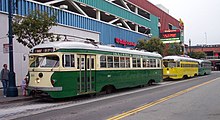
The
Boston's
Most heritage streetcar lines use overhead trolley wires to power the cars, as was the case with the vast majority of original streetcar lines. However, on the Galveston Island Trolley heritage line, which opened in 1988, using modern-day replicas of vintage trolleys, the cars were powered by an on-board diesel engine, as local authorities were concerned that overhead wires would be too susceptible to damage from hurricanes.[33] In spite of that precaution, damage in 2008 from Hurricane Ike was heavy enough to put the line out of service indefinitely, and as of 2021 it has yet to reopen, but three streetcars are being repaired and reopening is planned.[34]
Another heritage line lacking trolley wires was
In
Other seasonal or weekends-only heritage streetcar lines operate in Yakima, Washington (Yakima Electric Railway Museum); Fort Collins, Colorado; and Fort Smith, Arkansas. The Fort Collins and Fort Smith lines are both operated by an original (as opposed to replica) Birney-type streetcar, and in both cases the individual car in use is listed on the National Register of Historic Places.[38][39] In Philadelphia, the Penn's Landing Trolley operated seasonal and weekend service as a volunteer operation with former P&W equipment between September 1982 and December 17, 1995, on the Philadelphia Belt Line track on Columbus Boulevard in the historic Penn's Landing district.
Over 50 years later, the revival of extended
In San Francisco, parts of the cable car and Muni streetcar system (specifically the above-mentioned F Market & Wharves line) are heritage lines, although they are also functioning parts of the city's transit system. The cable cars are a National Historic Landmark and are rare examples of vehicles with this distinction. Located east of San Francisco is one of several museums in the U.S. that restore and operate vintage streetcars and interurbans, the Western Railway Museum.
In popular culture
The preservation of the
Many preserved railways also served as a filming location for several production companies; for example, the
Series three of Survivors uses heritage railways to help reestablish transportation, communication and trade in post-apocalyptic England.[citation needed]
See also
- Heritage streetcar
- List of heritage railways
- Restored train
- Gandy dancer
- Wilbert Awdry
References
- ^ "Minor and Heritage Railways". orr.gov.uk. Office of Rail and Road. Archived from the original on February 22, 2018. Retrieved August 16, 2018.
- ^ http://www.dzd-ussr.ru/towns/moscow/cpkio.html Children's railways: Gorky Park, Moscow (in Russian)
- ^ "'Children's railway' a training ground for future rail personnel". Archived from the original on 2014-11-06. Retrieved 2013-11-23.
- ^ http://www.gyermekvasut.hu/english/page.php?8 Archived 2013-12-03 at the Wayback Machine Budapest Children's railways website: Rolling Stock
- ^ http://www.visitkosice.eu/en/things-to-see-and-do/attractions/childrens-railway Archived 2013-12-03 at the Wayback Machine Košice Children's railways
- ^ http://www.worldrailfans.info/7.25inch/GalleryMersthamVRConstruction.shtml The only British children's railway that is operational in 2014
- ^ http://www.eastsurrey16mm.org.uk/ Helps keep the school's railway running, and puts on a number of steam and model train shows at that school
- ^ Kogan Page: Europe Review 2003/2004, fifth edition, Wolden Publishing Ltd, 2003, page 174 [1]
- ^ Centre, UNESCO World Heritage. "Budapest, including the Banks of the Danube, the Buda Castle Quarter and Andrássy Avenue". UNESCO World Heritage Centre.
- ^ 'El Kavanagh, entre los protegidos' Archived 2009-12-02 at the Wayback Machine, Clarín, 1999-04-23 (Spanish)
- ^ "Iguazu Argentina". Archived from the original on 2020-02-23. Retrieved 2020-02-23.
- ^ Tren turístico de Villa Elisa Archived 2015-06-06 at the Wayback Machine on Girasol Hostería
- ^ "15 trenes turísticos de la Argentina", Clarín, 24 May 2015
- ^ "Streetcar #400 | The Nelson Electric Tramway Society". Retrieved 2021-01-22.
- ^ "Streetcar #23 | The Nelson Electric Tramway Society". Retrieved 2021-01-22.
- ^ http://www2.liikennevirasto.fi/julkaisut/pdf3/lv_2012-05_finnish_railway_web.pdf Finnish Railway Network Statement 2014
- ^ http://www.rky.fi/read/asp/r_kohde_list.aspx the National Board of Antiquities' inventory of built cultural environments of national significance in Finland. In Finnish
- ^ http://nykarlebyjernvag.webs.com/inenglish.htm the National Board of Antiquities' inventory of built cultural environments of national significance in Finland. In Finnish
- ^ "Mountain Railways of India". World Heritage:UNESCO. Retrieved 2010-02-19.
- )
- ^ "Luxury Trains of India". Archived from the original on January 3, 2004. Retrieved 2010-02-20.
- ^ a b c d Gazzetta Ufficiale della Repubblica Italiana. "Legge 9 agosto 2017, n. 128".
- ^ a b "Tratte ferroviarie ad uso turistico" (PDF) (in Italian). Retrieved 24 February 2024.
- ^ a b c d e f g h i j k l m n o p q r A ordinary gauge, owned by RFI.
- narrow gauge, regional railway owned by Calabria railways; the service is called Trenino della Sila].
- ^ Subsequently extended to Isernia.
- ^ narrow gauge, regional railway owned by ARST; the service is called Trenino Verde.
- ^ a b Line part of the disused narrow gauge FS network of Sicily.
- ^ A ordinary gauge, regional railway owned by Ferrovienord.
- ^ a b c d "Gruppo FS, nasce la nuova società "FS Treni Turistici Italiani"" (in Italian). Retrieved 24 February 2024.
- ^ Electrification in German, French and Italian in the online Historical Dictionary of Switzerland.
- ^ Défilé de la «Crocodile» pour le plus grand plaisir du public, Swiss Federal Railways
- ISBN 0-9647279-2-7). St. Louis: Archway Publishing.
- ^ Tony Brooks, John Wayne Ferguson (September 16, 2018). "Under repair in Iowa, trolleys could roll again in 2019". Galveston County Daily News. Archived from the original on September 17, 2018. Retrieved May 8, 2021.
- ^ El Reno Attractions Archived April 29, 2009, at the Wayback Machine (El Reno Convention & Visitors Bureau)
- ^ El Reno, Oklahoma: Heritage Express Trolley (unofficial page)
- ^ Cornelius Swart (March 2, 2014). "TriMet to ship off Portland's iconic trolleys". Portland, Oregon: KGW. Archived from the original on March 5, 2014. Retrieved 2015-11-01.
- ^ "Fort Collins Municipal Railway Birney Safety Streetcar #21". Fort Collins History Connection. City of Fort Collins. 2009. Retrieved 2012-06-14.
- ^ "National Register of Historic Places: Search results for Fort Smith, Sebastian County". Arkansas Historic Preservation Program (an agency of the state government's Department of Arkansas Heritage). 2012. Retrieved 2012-06-14.[permanent dead link]
External links
- UK Heritage Railways
- International Working Steam
- Scenic railways in France mainline and tourist routes
- UK Heritage Railway Photographs
- Hungarian Interactive Railway Museum, Budapest Archived 2020-09-18 at the Wayback Machine
- Henry Williams Limited
